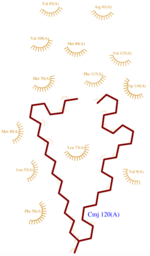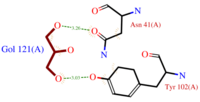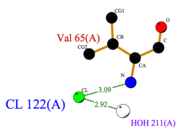Sandbox Reserved 960
From Proteopedia
(Difference between revisions)
| Line 18: | Line 18: | ||
===Location in the antenna and transport of pheromones=== | ===Location in the antenna and transport of pheromones=== | ||
| - | ASP1 is a protein which is only produced in the antenna of drones and workers bees. This organ constitutes one major component of the bees’ olfactory system. Cuticules structures of these antennas shelter sensillae which are a gate for pheromones. These sensillae contain neurons. Branched | + | ASP1 is a protein which is only produced in the antenna of drones and workers bees. This organ constitutes one major component of the bees’ olfactory system. Cuticules structures of these antennas shelter sensillae which are a gate for pheromones. These sensillae contain neurons. Branched endings are surrounded with sensillar lymph where ASP1 captures 9-ODA and transports it to pheromone receptor in the neuron membrane. PBP’s function is to solubilize hydrophobic odorant molecules, prevent their degradation and to transport them to reach the olfactory receptor. |
| - | ==Structure== | ||
| - | Domains and family | ||
| - | The C terminal(scene) domain of this molecule presents a characteristic PBP-GOP domain. While this protein is composed of 144 residues the domain PBP begin at the 25th residue. AmelASP1 binds its ligand at low pH and releases it at neutral pH. | ||
| - | |||
| - | ===Key residues=== | ||
| - | AmelASP1 is composed of 7 right-handed alpha helices | ||
| - | H1: residues 8–25 | ||
| - | H2: residues 27–36 | ||
| - | H3: residues 42–56 | ||
| - | H4: residues 66–74 | ||
| - | H5: residues 75–77 (rarely mentionned in publications because of its tiny size) | ||
| - | H6: residues 78–90 | ||
| - | H7: residues 96–112 | ||
| - | |||
| - | H1 has a break in the hydrogen-bonding pattern of its structure, forming tight substitute hydrogen bonds with water molecules. Thus, it results in a kink (at residue Ala 14) induced by a disruption in the helical conformation, due to hydrogen bonds with water molecules. | ||
===Components implicated in the structure rigidity=== | ===Components implicated in the structure rigidity=== | ||
AmelASP1 presents three disulfide bridges which are greatly enhancing its structure’s rigidity by linking four of the helices together. The six cysteines and their interval spacing are the most striking features shared by proteins belonging to the PBP family. | AmelASP1 presents three disulfide bridges which are greatly enhancing its structure’s rigidity by linking four of the helices together. The six cysteines and their interval spacing are the most striking features shared by proteins belonging to the PBP family. | ||
| - | The first disulfide bridge is established between H1 and H3 through Cysteins 20 and 51. An other disulfide bridge | + | The first disulfide bridge is established between H1 and H3 through Cysteins 20 and 51. An other disulfide bridge links H3 and H6 through Cys 47 and 98, and the third disulfide bridge connects H5 and H6 thanks to Cys 89 and Cys 107. |
Furthermore, non covalent bonds also play an important role. | Furthermore, non covalent bonds also play an important role. | ||
Indeed, at pH 5.5, Asp 66 and Leu 58 establish an hydrogene bond which is able to fix a key component structure such as H4. | Indeed, at pH 5.5, Asp 66 and Leu 58 establish an hydrogene bond which is able to fix a key component structure such as H4. | ||
| Line 63: | Line 48: | ||
=== Domains and family === | === Domains and family === | ||
| - | The C terminal(scene) domain of this molecule presents a characteristic PBP-GOP domain. While this protein is composed of 144 residues the domain | + | The C terminal(scene) domain of this molecule presents a characteristic PBP-GOP domain. While this protein is composed of 144 residues the PBP domain begins at the 25th residue. |
| + | |||
| Line 87: | Line 73: | ||
=== Cavity === | === Cavity === | ||
| - | The dynamic structure of the protein is responsible of the ligand’s binding by adjustment of position | + | The dynamic structure of the protein is responsible of the ligand’s binding by adjustment of position. The successful delivery of the effector to the receptor relies on this property. The ligand binding pocket consists in a cavity formed by the helices H2, H4 and H5 (scene), arranged in a globular shape which leads to a clear separation of the |
ligand from the hydrophilic environment. | ligand from the hydrophilic environment. | ||
The top of the cavity is not closed and can establish contacts with the solvent. The cavity is prone to accept ligand such as 9-ODA because of its specific composition. Indeed, cavity's components are mainly <scene name='60/604479/Hydrophobic_residues/2'>hydrophobic and aromatic</scene>.They consequently interact with the ligand's hydrophobic carbon chain and are localized on the internal face of the helix.Thus, it implies that these residues respect a regular distance pattern in the primary structure of the AmelASP1. | The top of the cavity is not closed and can establish contacts with the solvent. The cavity is prone to accept ligand such as 9-ODA because of its specific composition. Indeed, cavity's components are mainly <scene name='60/604479/Hydrophobic_residues/2'>hydrophobic and aromatic</scene>.They consequently interact with the ligand's hydrophobic carbon chain and are localized on the internal face of the helix.Thus, it implies that these residues respect a regular distance pattern in the primary structure of the AmelASP1. | ||
Revision as of 21:08, 23 December 2014
| This Sandbox is Reserved from 15/11/2014, through 15/05/2015 for use in the course "Biomolecule" taught by Bruno Kieffer at the Strasbourg University. This reservation includes Sandbox Reserved 951 through Sandbox Reserved 975. |
To get started:
More help: Help:Editing |
Crystal structure of the Antennal Specific Protein-1 from Apis mellifera (AmelASP1) with a serendipitous ligand at pH 5.5
| |||||||||||
References for further information on the pheromone binding protein from Apis mellifera
- ↑ Pesenti ME, Spinelli S, Bezirard V, Briand L, Pernollet JC, Tegoni M, Cambillau C. Structural basis of the honey bee PBP pheromone and pH-induced conformational change. J Mol Biol. 2008 Jun 27;380(1):158-69. Epub 2008 Apr 27. PMID:18508083 doi:10.1016/j.jmb.2008.04.048
- ↑ Pesenti ME, Spinelli S, Bezirard V, Briand L, Pernollet JC, Campanacci V, Tegoni M, Cambillau C. Queen bee pheromone binding protein pH-induced domain swapping favors pheromone release. J Mol Biol. 2009 Jul 31;390(5):981-90. Epub 2009 May 28. PMID:19481550 doi:10.1016/j.jmb.2009.05.067
- ↑ Han L, Zhang YJ, Zhang L, Cui X, Yu J, Zhang Z, Liu MS. Operating mechanism and molecular dynamics of pheromone-binding protein ASP1 as influenced by pH. PLoS One. 2014 Oct 22;9(10):e110565. doi: 10.1371/journal.pone.0110565., eCollection 2014. PMID:25337796 doi:http://dx.doi.org/10.1371/journal.pone.0110565
- ↑ Lartigue A, Gruez A, Briand L, Blon F, Bezirard V, Walsh M, Pernollet JC, Tegoni M, Cambillau C. Sulfur single-wavelength anomalous diffraction crystal structure of a pheromone-binding protein from the honeybee Apis mellifera L. J Biol Chem. 2004 Feb 6;279(6):4459-64. Epub 2003 Oct 31. PMID:14594955 doi:10.1074/jbc.M311212200
- ↑ http://www.genome.jp/dbget-bin/www_bget?pdb:3FE6



